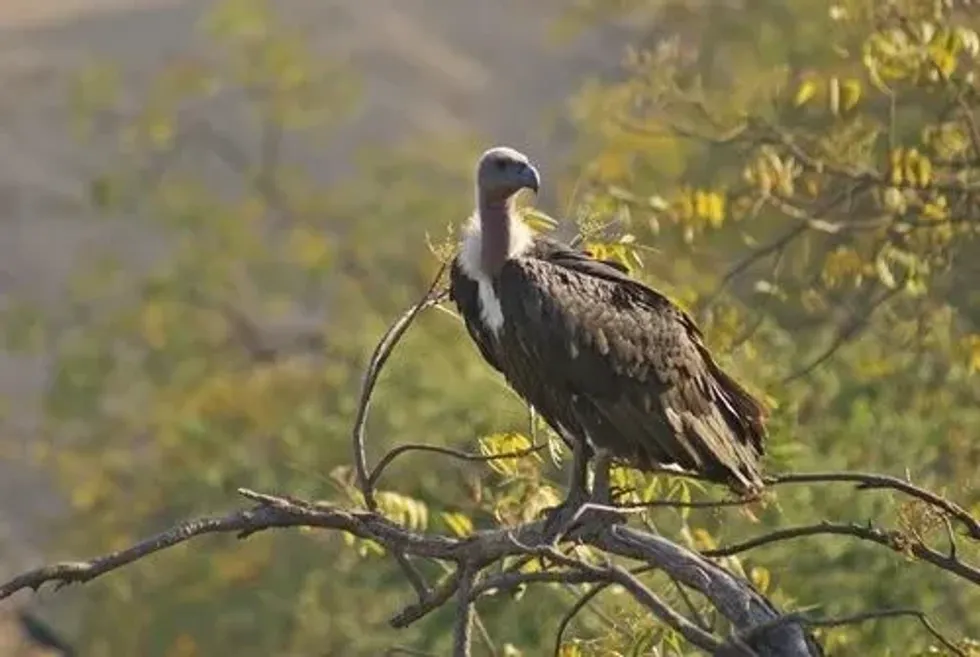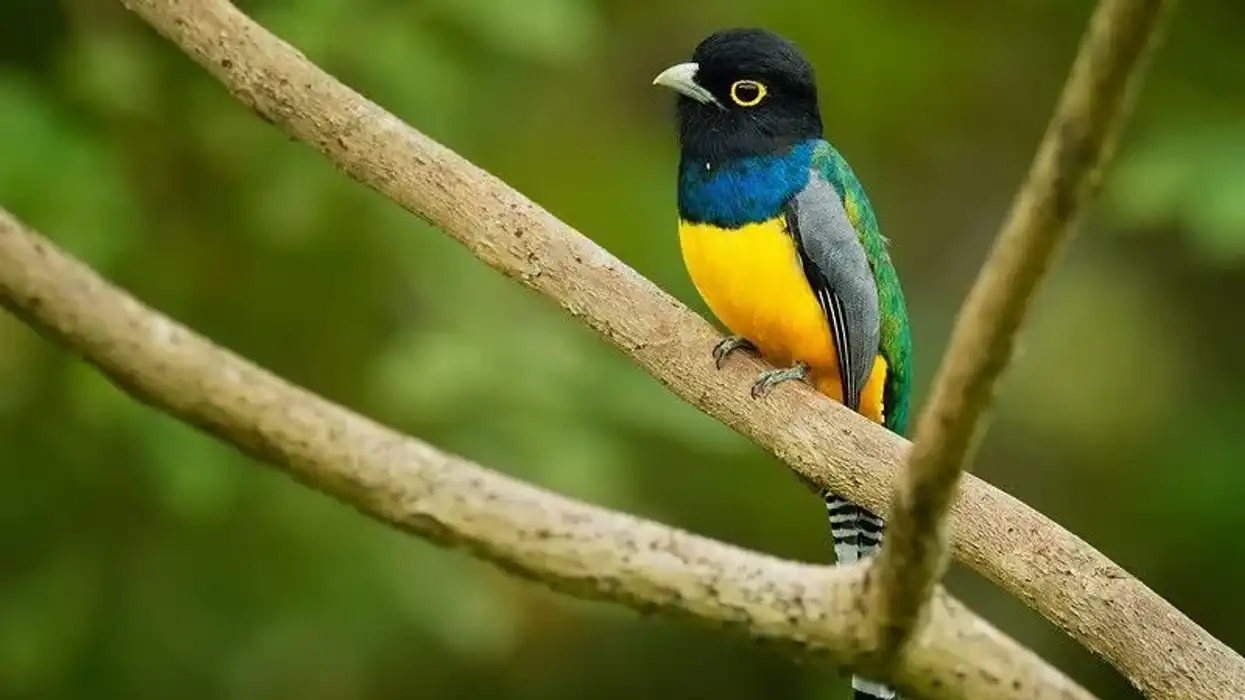Vultures are birds of prey distinguished for their peculiar appearance and sharp vision. Vultures are linked to mythology and culture as well.
In ancient Egypt, the goddess Nekhbet is depicted as a vulture. Vultures are mentioned in the Mesoamerican myths.
Even in Asia, vultures play a crucial role in the Vajrayana Buddhist culture. Vultures are further divided into the New World vulture and the Old World vulture.
The white-rumped vulture is one of the species from the Old World that is thought to be a native South and Southeast Asian species. This species is the smallest of all the vultures under the genus Gyps and is believed to be closely related to the Gyps fulvus or griffon vultures.
This medium-sized vulture that was once widely observed has been subjected to a drastic population decline. Apart from scavenging on the carcass of dead animals, these vultures are rarely seen.
These vultures usually have their dwellings near a human settlement where they can find abundant food and are near to a water source. The white-rumped vulture is a Critically Endangered species as they are natural scavengers, however their declining population is affecting the ecosystem.
Do you want to learn more about the white-rumped vulture? Keep reading this article as more fascinating facts about them are below. If you enjoy learning about the white-winged fairy-wren, you may also like to read about the hawk and house wren.
White-Rumped Vulture Interesting Facts
What type of animal is a white-rumped vulture?
The white-rumped vulture (Gyps bengalensis) is a Critically Endangered bird of prey that was once plentiful in the region of South Asia and Southeast Asia.
What class of animal does a white-rumped vulture belong to?
The Gyps bengalensis belongs to the class of Aves, order Accipitriformes, and family Accipitridae. It is monotypic and has no subspecies.
How many white-rumped vultures are there in the world?
The population of the white-rumped vulture was substantial until 1985. However, after the '90s their population fell rapidly due to many factors. The current population of this species according to BirdLife International ranges somewhere between 3500-15,000, including adult and young birds.
Once there were over several million birds but now only 15,000 birds are left. White-rumped vultures have already disappeared in several Asian countries like Malaysia and an insufficient amount resides in the northern region of Asia. Between 2000-2007, the percentage of Indian white-rumped vulture dropped by 43.9%.
Where does a white-rumped vulture live?
The white-rumped vulture is closely related to the Gyps fulvus, however, their range is limited within the territories of Asia. The Gyps bengalensis can be found primarily in the Indian subcontinent including India, Pakistan, Bangladesh, Bhutan, Nepal, Burma, Vietnam, Cambodia, Laos, and Thailand.
This species was also observed in some parts of Afghanistan, mainly in the southern region but also in central areas too.
These birds are now rarely seen and have become extinct in countries like Malaysia. Indian white-rumped vultures were largely seen in the Indo-Gangetic plains particularly near cremation areas.
What is a white-rumped vulture's habitat?
The white-rumped vulture habitat can be described as lowlands however, there is evidence of them flying at a height of 4291 ft (1307.8 m) in the foothills of the Himalayas. This species of vulture prefers living near a human settlement.
They can be discovered flying over towns, villages, cities, and sanctuaries. Vultures are endowed with strong eyesight and this enables them to locate their prey. They build their nests on trees and cliffs and these nests are built by both the male and female vultures.
Their nest is primarily made of twigs and lined with green leaves. Building a nest near human settlements makes foraging easy for them.
Who do white-rumped vultures live with?
This species is considered to be a social creature as it can be seen in flocks even while scavenging on dead animals. They can also be seen in the company of other vulture species.
How long does a white-rumped vulture live?
The average lifespan of the white-rumped vulture in the wild is not determined, However, in captivity, this bird can live to 17 years of age.
How do they reproduce?
The breeding season of the white-rumped vulture (Gyps bengalensis) begins in October and is extends to March. Their mating system within the season is monogamous and they breed once a year.
The process is initiated with the construction of nests. Male vultures gather branches and twigs while the female vultures arrange them.
The breeding colonies are primarily on rocky cliffs or huge trees. Both the male and female vultures can be seen flying in pairs closer to their breeding territories. The nest must be spacious and is mostly built in a place that is safe from other terrestrial predators.
These vultures reproduce by copulation that involves a loud cry. The male vulture mounts the female and fastens the female’s head in its beak.
After copulating successfully, the female primarily lays one egg. The incubation period is almost 45 days and it is done by both the male and female vulture. The young bird stays in the nest for two to three months, after which it fledges.
What is their conservation status?
The conservation status of this vulture species according to the International Union for Conservation of Nature is Critically Endangered. This species is now rarely observed as their population has declined after 1990. Out of all the causes, the major cause is the usage of diclofenac in veterinary treatment because scavenging on carcasses treated by diclofenac leads to poisoning.
White-Rumped Vulture Fun Facts
What do white-rumped vultures look like?
Once the most abundant species, these vultures are now currently Critically Endangered. The white-rumped vulture (Gyps bengalensis) is a medium-sized vulture, even though it is deemed as the smallest species in the Gyps genus.
This species of vulture has wide wings and the wingspan is nearly 70.9-82.7 in (180-210 cm) but their tail feather is short. It is approximately 29.9-36.6 in (76-93 cm) in length and weighs 7.7-13.2 lb (3492.6-5987.4 g).
Overall, these vultures are dark and their plumage can be defined as blackish. The presence of a white neck ruff and the patch of white feathers on its back is the explanation behind its name ‘white rumped’.
Underneath their wing is dark brown while the upper part is slightly grayish.
Their undertail coverts are black. The Gyps bengalensis has short and stout beaks while its eyes are yellow which is another striking feature.
The juveniles do not have a plumage as dark as the adult because they plumage changes as they grow. It is also observed that in an immature Gyps bengalensis, the rump region is not white but dark brown.

How cute are they?
These birds can be intimidating because of their size and also because they are birds of prey. They may not be considered cute, just like griffon vultures.
How do they communicate?
Gyps bengalensis vultures have distinct sets of sounds and tones to communicate with. They grunt, hiss, squeal, and even screech or laugh.
How big is a white-rumped vulture?
This species of vulture is thought to be the smallest under the Gyps genus. They are approximately 29.9-36.6 in (76–93 cm) in length and have a wingspan of 6.3–8.5 ft (1.92–2.5 m). The Gyps bengalensis is bigger than the black vulture which is 22-29 in (55.8-73.6 cm).
How fast can a white-rumped vulture fly?
The average speed is 50-55 mph (80.4-88.5 kph), however, the maximum speed this vulture can reach is 90 mph (144.8 kph).
How much does a white-rumped vulture weigh?
The average weight of the Gyps bengalensis is almost 7.7-13.2 lb (3492.6-5987.4 g).
What are the male and female names of the species?
There are no unique names that have been assigned to a male or female white-rumped vulture.
What would you call a baby white-rumped vulture?
A baby white-rumped vulture is called a chick. The major threat facing the eggs is predators which may include python, lizards, and other carnivores.
What do they eat?
The Gyps bengalensis are scavengers and they scavenge on carrion, particularly cattle. They also feed on the remains of other mammals including their own kind.
Are they dangerous?
The Gyps bengalenesis feed mainly on dead carcasses. Despite their intimidating appearance, they do not intend to cause any harm to human beings, however, there can be exceptions.
Would they make a good pet?
No, the population status of the Gyps bengalensis is critical. This means captivating them without any purpose is not right.
Did you know...
The white-rumped vulture and the white-backed vulture which is an African species were believed to be closer, thus it was once called the oriental white-backed vulture.
If the female white-rumped vulture loses an egg, she will destroy the entire nest.
Why is the white-rumped vulture endangered?
The white-rumped vulture (Gyps bengalensis) is a Critically Endangered species and its conservation status is confirmed by the IUCN.
This species of vulture was once abundantly found in India, Bangladesh, Pakistan, Nepal, Bhutan, Vietnam, Thailand, and other South and Southeast Asian countries. It was documented in a survey in the '80s that the white-rumped vulture was the most abundant species while a survey held in 2016 found that approximately only 10,000 individuals were left.
This decline has severely affected the ecosystem because these vultures are natural scavengers that keep the environment clean and stop the spread of diseases.
One of the major causes associated with the decline of the population is the use of diclofenac in veterinary treatment.
The boost of fertilizers, insecticides, and other factors including the shortage of food, hunting, and intentional poisoning have all lead to the critical status of this species. The Gyps bengalensis has vanished in the south of China and Malaysia while in India and Pakistan the population has declined by 95%.
Several initiatives have been taken regarding the restoration of their statuses like banning the use of diclofenac and captive breeding programs.
Naming the white-rumped vulture's wings
The medium-sized dark vulture is a unique species. Adults have blackish plumage covering the entire body except for its head and neck.
The Gyps bengalensis has a white neck ruff and a white patch of feathers on the lower back of its body and also on its upper tail. This peculiar appearance is why they are called the white-rumped vulture.
Here at Kidadl, we have carefully created lots of interesting family-friendly animal facts for everyone to discover! For more relatable content, check out these bowerbird facts and umbrellabird facts for kids.
You can even occupy yourself at home by coloring in one of our free printable white-rumped vulture coloring pages.
Second image by Davidvraju.










